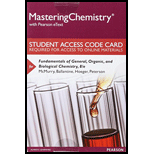
a)
Interpretation: Element from each pair of atoms that has the larger IE and high EA to be predicted.
Concept Introduction:
Ionization energy: The amount of energy required to remove an electron from the gaseous atom.
b)
Interpretation: Element that loses an electron more easily to be predicted.
Concept Introduction:
Ionization energy: The amount of energy required to remove an electron from the gaseous atom.
Electron Affinity: The amount of energy released when an electron is added to gaseous atom.
c)
Interpretation: Element that loses an electron more easily to be predicted.
Concept Introduction:
Ionization energy: The amount of energy required to remove an electron from the gaseous atom.
Electron Affinity: The amount of energy released when an electron is added to gaseous atom.
Want to see the full answer?
Check out a sample textbook solution
Chapter 3 Solutions
Mastering Chemistry with Pearson eText -- Standalone Access Card -- for Fundamentals of General, Organic, and Biological Chemistry (8th Edition)
- Figure 2.7 An atom may give, take, or share electrons with another atom to achieve a full valence shell, the most stable electron configuration. Looking at this figure, how many electrons do elements in group 1 need to lose in order to achieve a stable electron configuration? How many electrons do elements in groups 14 and 17 need to gain to achieve a stable configuration?arrow_forwardMagnesium has an atomic number of 12. Which of the following statements is true of a neutral magnesium atom? a. It has 12 protons, 12 electrons, and 12 neutrons. b. It has 12 protons, 12 electrons, and six neutrons. c. It has six protons, six electrons, and no neutrons. d. It has six protons, six electrons, and six neutrons.arrow_forwardVisit this website (http://openstaxcollege.org/l/ptable) to view the periodic table. In the periodic table of the elements, elements in a single column have the same number of electrons that can participate in a chemical reaction. These electrons are known as valence electrons. For example, the elements in the first column all have a single valence electron—an electron that can be donated in a chemical reaction with another atom. What is the meaning of a mass number shown in parentheses?arrow_forward
- Look up antimony in the periodic table 1Z = 512. How many covalent bonds would you expect it to form? Based on this information, which of the following antimony compounds is covalent and which is ionic: SbCl3 or SbCl5?arrow_forwardWrite the electron configurations of Co, Co2+ , and Co3+.arrow_forwardWhich element is likely to lose an electron more easily, Mg or S?arrow_forward
- How many electrons does a neutral Chlorine (Cl) atom have in its outermost electron shell?arrow_forwardA carbon atom contains six protons and six neutrons.A. What are its atomic number and atomic weight?B. How many electrons does it have?C. How many additional electrons must it add to fill its outermost shell? How does this affect carbon’s chemical behavior?D. Carbon with an atomic weight of 14 is radioactive. How does it differ in structure from nonradioactive carbon? How does this difference affect its chemical behavior?arrow_forwardWhen two atoms share a pair of valence electrons with different levels of electronegativity, what type of bond is this?arrow_forward
- The triple point of an element is at 75 torr and 125°C. This means that liquid is more dense than solid cannot exist at 1 atmosphere pressure cannot have a vapor pressure less than 75 torr cannot exist above 125 degrees Celsius What is the electron geometry (or electron arrangement) around an atom in a molecule or ion which is surrounded by three lone pairs of electrons and two single bonds T-shaped see-saw trigonal planar trigonal bipyramidal linear A red blood cell placed in pure water will swell because water moves from a higer osmotic pressure to a lower osmotic pressure the osmotic pressure is greater in the cell than in the water the osmotic pressure is the same in the cell and the water the somotic pressure is greater in the water than in the cellarrow_forwardAn ion has 15 protons, 16 neutrons, and 18 electrons. The symbol for the ion is 31P3+. 31P3-. 31Ar3+. 34S+. 34S-.arrow_forwardWhat are the formal charges present in in the ion CH3NH3+? Assume all atoms other an hydrogen have an octet and that there are two central atoms. N is +1 and C is 0 N is +1 and C is -1 N is 0 and C is 0 N is +2 and C is -1 N is 0 and C is +1arrow_forward
 Concepts of BiologyBiologyISBN:9781938168116Author:Samantha Fowler, Rebecca Roush, James WisePublisher:OpenStax College
Concepts of BiologyBiologyISBN:9781938168116Author:Samantha Fowler, Rebecca Roush, James WisePublisher:OpenStax College Biology Today and Tomorrow without Physiology (Mi...BiologyISBN:9781305117396Author:Cecie Starr, Christine Evers, Lisa StarrPublisher:Cengage Learning
Biology Today and Tomorrow without Physiology (Mi...BiologyISBN:9781305117396Author:Cecie Starr, Christine Evers, Lisa StarrPublisher:Cengage Learning Biology 2eBiologyISBN:9781947172517Author:Matthew Douglas, Jung Choi, Mary Ann ClarkPublisher:OpenStax
Biology 2eBiologyISBN:9781947172517Author:Matthew Douglas, Jung Choi, Mary Ann ClarkPublisher:OpenStax Anatomy & PhysiologyBiologyISBN:9781938168130Author:Kelly A. Young, James A. Wise, Peter DeSaix, Dean H. Kruse, Brandon Poe, Eddie Johnson, Jody E. Johnson, Oksana Korol, J. Gordon Betts, Mark WomblePublisher:OpenStax College
Anatomy & PhysiologyBiologyISBN:9781938168130Author:Kelly A. Young, James A. Wise, Peter DeSaix, Dean H. Kruse, Brandon Poe, Eddie Johnson, Jody E. Johnson, Oksana Korol, J. Gordon Betts, Mark WomblePublisher:OpenStax College



